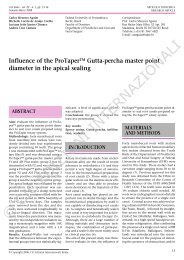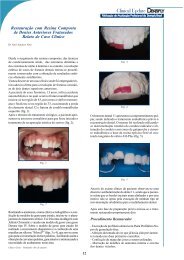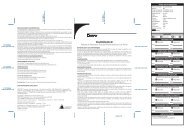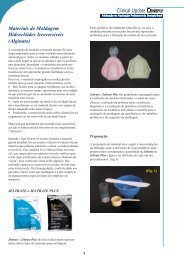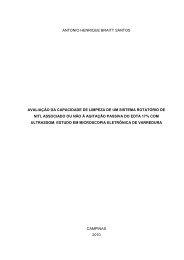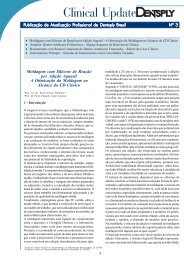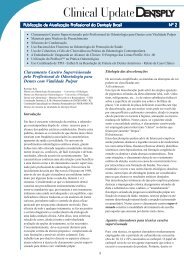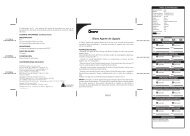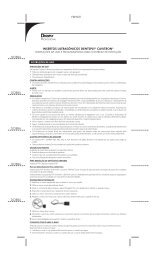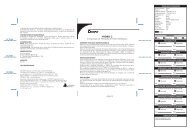You also want an ePaper? Increase the reach of your titles
YUMPU automatically turns print PDFs into web optimized ePapers that Google loves.
Latta<br />
Table 1 Mean shear bond strength (SBS) for each group (in MPa)<br />
Bonding Agent Mean SBS to dentin (MPa) Mean SBS to enamel (MPa)<br />
Optibond Solo plus 26.5 ± 2.9 28.3 ± 4.8<br />
XP Bond 25.8 ± 2.6 28.3 ± 4.7<br />
Adper Scotchbond 1 XT 24.2 ± 3.4 26.5 ± 4.9<br />
Syntac Classic (15-s etch) 13.2 ± 3.7* 21.6 ± 5.8*<br />
* Significantly different compared to the other groups (p < 0.05)<br />
mens in air or water, at room temperature and pressure, and<br />
without destroying the specimen.<br />
A new etch-and-rinse adhesive called XP Bond has been<br />
developed that has several unique compositional components.<br />
It is hypothesized that these components will allow<br />
the adhesive formula to be less sensitive to residual dentin<br />
moisture and allow full resin penetration under a wide range<br />
of dentin conditions. Second, this adhesive contains phosphate<br />
esters that may chemically interact with the mineral<br />
apatite component of dentin and enamel. The purpose of<br />
this study was to evaluate the shear bond strength of composite<br />
to dentin and enamel using this new adhesive system.<br />
In addition, micro-Raman spectroscopy was performed to<br />
determine if there was a chemical interaction between the<br />
resin adhesive and dentin and enamel.<br />
MATERIALS AND METHODS<br />
Shear Bond Strength<br />
Flat bonding sites were prepared on the buccal surfaces of<br />
96 extracted human teeth by grinding the teeth on a watercooled<br />
abrasive wheel (Ecomet III Grinder, Lake Bluff, IL,<br />
USA) to a 600-grit surface exposing dentin on 48 specimens<br />
and enamel on 48 specimens. Twelve specimens each for<br />
enamel and dentin for each adhesive were prepared. The adhesives<br />
and conditions of use were:<br />
• Group 1: XP Bond (lot 0503004020) cured for 10 s with<br />
the SmartLite LED curing light.<br />
• Group 2: Optibond Solo Plus (lot 437041) cured for 10 s<br />
with the SmartLite LED curing light.<br />
• Group 3: Adper Scotchbond 1 XT (lot 230270) for 10 s<br />
with the SmartLite LED curing light.<br />
• Group 4: Syntac Classic (lot G06551) using phosphoric<br />
acid etch 15 s and cured for 10 s with the SmartLite LED<br />
curing light.<br />
DeTrey tooth conditioner (<strong>Dentsply</strong> Detrey; Konstanz, Germany;<br />
lot 0403000687) was used to condition all surfaces<br />
prior to placement of the adhesive. After the application of<br />
the adhesive system, cylinders of composite resin (Spectrum<br />
TPH Shade A2, lot 0411002236; <strong>Dentsply</strong> DeTrey; Konstanz,<br />
Germany) were bonded to each dentin and enamel<br />
bonding site. A gelatin capsule technique in which a resin<br />
cylinder 4.5 mm in diameter is employed as a matrix was<br />
used. Composite was loaded in the capsules approximately<br />
two-thirds full, then cured in a Triad 2000 curing unit (Trubyte<br />
Division, DENTSPLY International; York, PA, USA) for 1 min.<br />
Additional composite was added to slightly overfill the capsules.<br />
The capsules were firmly seated against the bonding<br />
sites and excess resin removed with a dental explorer. The<br />
resin was visible-light cured with three 20-s curing sequences,<br />
each from opposite sides of the capsule at an angle<br />
of 45 degrees to the tooth surface.<br />
The specimens were stored in distilled water at 37°C for<br />
24 h. Twelve specimens for each adhesive/tooth structure<br />
combination were thermocycled between water baths of 5°C<br />
and 55°C for 6000 cycles (dwell time 20 s). The specimens<br />
were mounted in acrylic and loaded to failure in an Instron<br />
Testing Machine (Model 1123, Instron; Canton, MA, USA)<br />
equipped with a chisel-shaped rod. Each bonded cylinder<br />
was placed under continuous loading at 5 mm per min until<br />
fracture occurred. Shear bond strength was calculated in<br />
MPa.<br />
Raman Spectroscopy<br />
Extracted third molars were prepared by grinding enamel<br />
and dentin to a 600-grit surface. The experimental adhesive<br />
was applied and composite resin placed over the adhesive<br />
film. After water storage, the teeth were sectioned to expose<br />
the tooth/adhesive interface and polished to 4000 grit with<br />
silicon carbide paper. Specimens were placed on an X-Y<br />
scanning stage in a Jasco 3100 laser Raman Spectrometer<br />
(Jasco; Tokyo, Japan). The excitation was derived from a<br />
785-nm source at an output level of 35 mW and focused<br />
through an X100 near-IR lens to ~ 1 μm beam diameter.<br />
Wavenumber calibration was determined by comparison of<br />
spectra from pure silicon (520 cm -1 ).<br />
RESULTS AND DISCUSSION<br />
Shear Bond Strength<br />
The mean shear bond strength (in MPa) for each group is displayed<br />
in Table 1. A one-way ANOVA was done for the dentin<br />
and enamel groups. The level of significance for dentin was<br />
p < 0.0001, and for enamel p = 0.0168. A post-hoc LSD test<br />
was done for pair-wise comparison. The group marked by an<br />
asterisk was statistically different compared to the other<br />
groups (p < 0.05).<br />
246 The Journal of Adhesive Dentistry



